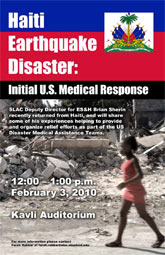

Wednesday - February 17, 2010
SLAC Today is
available online at:
http://today.slac.stanford.edu
In this issue:
LCLS Team Puts the 'Ultra' in 'Ultrafast'
Sherin to Present on Haiti Disaster Relief Today
 |
 |
|
Wednesday - February 17, 2010 |
LCLS Team Puts the 'Ultra' in 'Ultrafast'As Einstein pointed out, time is relative. For astrophysicists investigating galaxies light years away, a decade is a pinprick on a long continuum. For particle physicists tracing the movement of photons and electrons, a second is an eternity. For instance, consider the femtosecond. It is one quadrillionth of a second, or one over ten to the power of fifteen. In 100 femtoseconds, a particle moving at the speed of light travels the same distance as the thickness of a single sheet of paper. The Linac Coherent Light Source at SLAC provides astonishingly bright laser X-rays in 100 femtosecond pulses of photons, emitted by similarly brief bunches of electrons bouncing through the LCLS undulator magnets at nearly the speed of light. For scientists wishing to study molecular structure, the 100 femtosecond pulses make the LCLS a remarkable tool. But for physicists eager to see atoms in motion, 100 femtoseconds is a bit too long. With a few setting changes, last fall the LCLS team achieved pulses as brief as 10 femtoseconds, and scientists hope to make them shorter still. "These are much shorter pulses than other X-ray sources," said Joe Frisch, part of the accelerator physics group that originated the LCLS approach to achieving short pulses. The idea was to lower the charge in the electron beam, which means fewer electrons are in each bunch. This gives SLAC scientific users a distinct edge at probing what can happen in these brief, femtosecond windows. Short bunches were a sweet and unexpected surprise for LCLS users during the machine's first user run last fall. "Every user group wanted to use the new short bunch mode," said Rick Iverson, the LCLS program coordinator. "They were able to do more than they expected. It was a bonus for them." After the LCLS was up and running with pulses at 100 femtoseconds, scientists decided to try an even shorter mode. First, they modeled the experiment on a computer to see if it would work. When the model did not throw up any red flags, they changed the settings on the LCLS and fired away. According to indirect measurements and computer simulations, they should be getting around 10 femtosecond bunches, but no one knows for sure. These sub-100 femtosecond pulses are so infinitesimally tiny that current electronic technology is unable to gauge the precise length. Short bunches will force physicists to devise new techniques.  Sherin will reprise his February 3 presentation
today. (Poster by SLAC Infomedia Solutions.)
Sherin to Present on Haiti Disaster Relief TodayDon't forget to head down to campus today at lunch time to see Deputy Director for Environment, Safety and Health Brian Sherin present his striking photos and stories of his experiences with the U.S. emergency response after the Haiti earthquake. Sherin's talk will take place at Stanford's Clark Center auditorium today at noon. Special Presentation at Stanford: Brian Sherin's Experiences with Emergency Response in Haiti |
Events
Access (see all)Announcements
|
|
| | ||
|
|
||
 <%
Response.AddHeader "Last-modified", getArticleDate()
'Response.AddHeader "Last-modified","Mon, 01 Sep 1997 01:03:33 GMT"
'Monday, December 06, 2010
%>
<%
Response.AddHeader "Last-modified", getArticleDate()
'Response.AddHeader "Last-modified","Mon, 01 Sep 1997 01:03:33 GMT"
'Monday, December 06, 2010
%>View online at http://today.slac.stanford.edu/. |
||